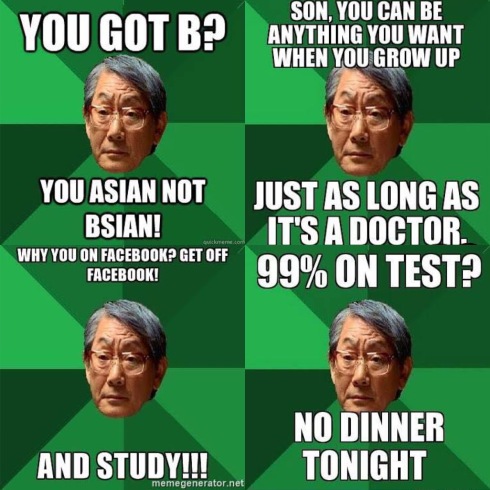Singapore is the second most competitive country in the world according to the World Economic Forum (Schwab 2014). Regarding to this, Singapore has a really fast paced growth and a highly productivity in economic sector. As I was born and raised in a Chinese family in Indonesia, in which geographically relative to be close to Singapore, I have been exposed to some of Singaporean culture as I have also been there several times for holiday. There is one famous Singapore culture that I find it interesting, in which they called it “kiasu”. Kiasuism is originated from the word Kiasu which originates from Chinese word 怕输 meaning “the fear of losing out” (Wah!Banana 2014). It describes a grasping or a very determined attitude, or can also act as an adjective, which portrays a person being very anxious not to miss an opportunity. This mentality can be seen through analysing the behavior of Singaporeans in difference aspects such as the educational disciplinary, working style and daily lifestyle.
In education, most Singaporean students are mark-orientated individuals. They have this perception of school that they come to school just for the sake of pursuing good grades. Intellectual curiosity comes next after they had received excellent grades from their examination. The pressure that the Singapore students are experiencing is tremendously huge and mainly comes from their own parents (Ho et al. 1998). I found this meme that funnily described how Singapore or typical Asian parents are expecting from their children.

Singapore parents have this mindset that if they want to be success, they need an outstanding grade and a really hardworking attitude to be able to go to a high ranking University. In Singapore, a high ranking and credible University such as National University Singapore and Nanyang Technology University, are considered to be the most determining factor of job security, which is crucial for many Singaporeans (Wong 2017).
A Singaporean movie entitled “I Not Stupid” also illustrates in an entertaining way of how kiasuism in Singapore looks like and how the parents discipline their kids. There is another entertaining video created by Singaporean famous YouTuber Wah!Banana that demonstrates the kiasuism of Singaporeans in a humorous approach. One of the most noticeable aspect described here is when the two students are competing to do more paper works to be the best among each other. They are not driven by the idea to be the best version of themselves but their success are determined by their friend’s effort.
The working style in Singapore has a really competitive approach. Singaporeans are known to always strive for the better and more innovative results than their working partners. Stealing ideas from people are really known to be very normal in Singapore and this explains the reason why Singaporeans are very individualistic in their workplace. This particular behavior had been ingrained in their DNA since they are young (Ngerng 2017).
However, kiasu also brings a positive impact towards the business and the country itself. In terms of labour market, labour force and human resource, Singapore is prevalent in its workforce capability (Buzzle 2017). According to Kee-Man Chuah (2017), this behavior may drive a person’s willingness to avoid themselves from poverty in any circumstances. Kiasuism has a significance for a person’s wellbeing. This behaviour has pushed them not to be lazy and to excel whenever they are in extreme situations and various fields. This also motivates Singaporeans to achieve their best although they have limited resources in their country. Perhaps, this is one of the main factor how Singapore has become a developed country in just 50 years of time.
References:
Bsian not asian 2017, quickmeme, viewed 20 January 2017, <http://www.quickmeme.com/p/3vspzs>.
Chuah, K. 2017, Portrayal of “Kiasu” Singaporean Society in Rice Bowl: Beyond the Fear Factor, Academia Edu, viewed 19 January 2017, <http://www.academia.edu/3851882/Portrayal_of_Kiasu_Singaporean_Society_in_Rice_Bowl_Beyond_the_Fear_Factor>.
Ho, J., Ang, C., Loh, J. and Ng, I. 1998, ‘A preliminary study of kiasu behaviour ‐ is it unique to Singapore?’, Journal of Managerial Psychology, vol. 13, no. 5-6, pp.359-370.
Ngerng, R. 2012, Singaporeans are Kiasu: Is It Good or Bad for Singaporeans?, The Heart Truths, viewed 19 January 2017, <https://thehearttruths.com/2012/08/25/singaporeans-are-kiasu-is-it-good-or-bad-for-singaporeans/>.
Schwab, K. 2014, The Global Competitiveness Report 2014–2015, World Economic Forum, Geneva.
Understanding the Work Culture in Singapore Prior to Moving Base 2011, Buzzle, viewed 19 January 2017, <http://www.buzzle.com/articles/work-culture-in-singapore.html>.
Wah!Banana 2014, #KiasuSingaporean, video comedy, YouTube, viewed 20 January 2017 <https://www.youtube.com/watch?v=hyrEOOJThdI>.
Wong, P. 2017, Being Kiasu, BananaWriters, viewed 20 January 2017, <http://www.bananawriters.com/beingkiasumrkiasu>.
